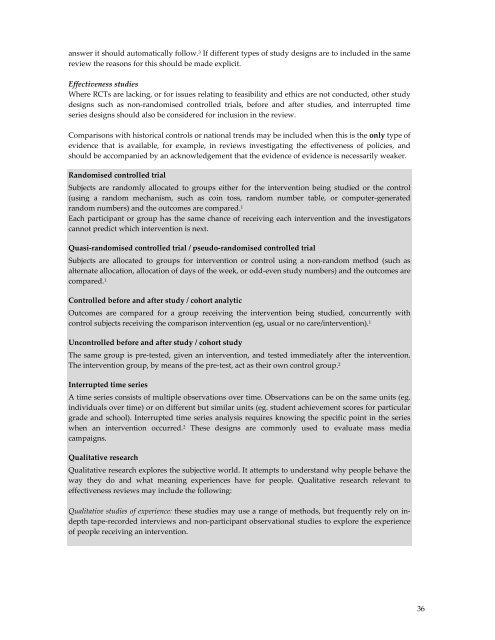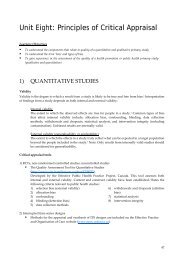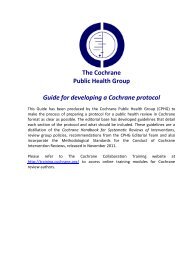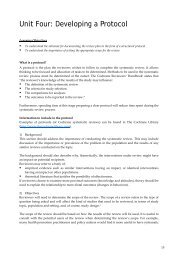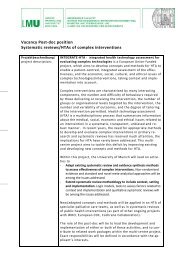Train the Trainer Course book - Cochrane Public Health Group
Train the Trainer Course book - Cochrane Public Health Group
Train the Trainer Course book - Cochrane Public Health Group
Create successful ePaper yourself
Turn your PDF publications into a flip-book with our unique Google optimized e-Paper software.
answer it should automatically follow. 3 If different types of study designs are to included in <strong>the</strong> same<br />
review <strong>the</strong> reasons for this should be made explicit.<br />
Effectiveness studies<br />
Where RCTs are lacking, or for issues relating to feasibility and ethics are not conducted, o<strong>the</strong>r study<br />
designs such as non-randomised controlled trials, before and after studies, and interrupted time<br />
series designs should also be considered for inclusion in <strong>the</strong> review.<br />
Comparisons with historical controls or national trends may be included when this is <strong>the</strong> only type of<br />
evidence that is available, for example, in reviews investigating <strong>the</strong> effectiveness of policies, and<br />
should be accompanied by an acknowledgement that <strong>the</strong> evidence of evidence is necessarily weaker.<br />
Randomised controlled trial<br />
Subjects are randomly allocated to groups ei<strong>the</strong>r for <strong>the</strong> intervention being studied or <strong>the</strong> control<br />
(using a random mechanism, such as coin toss, random number table, or computer-generated<br />
random numbers) and <strong>the</strong> outcomes are compared. 1<br />
Each participant or group has <strong>the</strong> same chance of receiving each intervention and <strong>the</strong> investigators<br />
cannot predict which intervention is next.<br />
Quasi-randomised controlled trial / pseudo-randomised controlled trial<br />
Subjects are allocated to groups for intervention or control using a non-random method (such as<br />
alternate allocation, allocation of days of <strong>the</strong> week, or odd-even study numbers) and <strong>the</strong> outcomes are<br />
compared. 1<br />
Controlled before and after study / cohort analytic<br />
Outcomes are compared for a group receiving <strong>the</strong> intervention being studied, concurrently with<br />
control subjects receiving <strong>the</strong> comparison intervention (eg, usual or no care/intervention). 1<br />
Uncontrolled before and after study / cohort study<br />
The same group is pre-tested, given an intervention, and tested immediately after <strong>the</strong> intervention.<br />
The intervention group, by means of <strong>the</strong> pre-test, act as <strong>the</strong>ir own control group. 2<br />
Interrupted time series<br />
A time series consists of multiple observations over time. Observations can be on <strong>the</strong> same units (eg.<br />
individuals over time) or on different but similar units (eg. student achievement scores for particular<br />
grade and school). Interrupted time series analysis requires knowing <strong>the</strong> specific point in <strong>the</strong> series<br />
when an intervention occurred. 2 These designs are commonly used to evaluate mass media<br />
campaigns.<br />
Qualitative research<br />
Qualitative research explores <strong>the</strong> subjective world. It attempts to understand why people behave <strong>the</strong><br />
way <strong>the</strong>y do and what meaning experiences have for people. Qualitative research relevant to<br />
effectiveness reviews may include <strong>the</strong> following:<br />
Qualitative studies of experience: <strong>the</strong>se studies may use a range of methods, but frequently rely on indepth<br />
tape-recorded interviews and non-participant observational studies to explore <strong>the</strong> experience<br />
of people receiving an intervention.<br />
36


